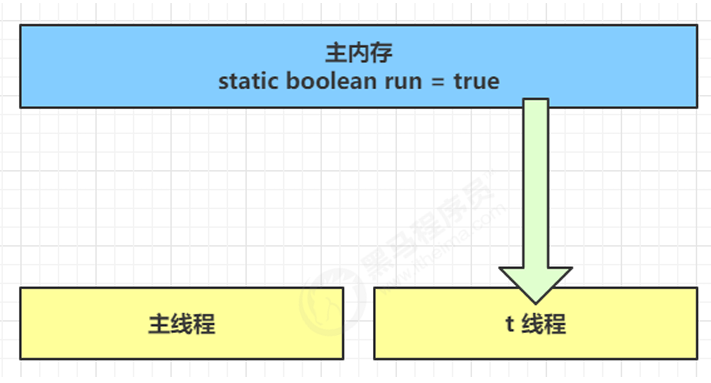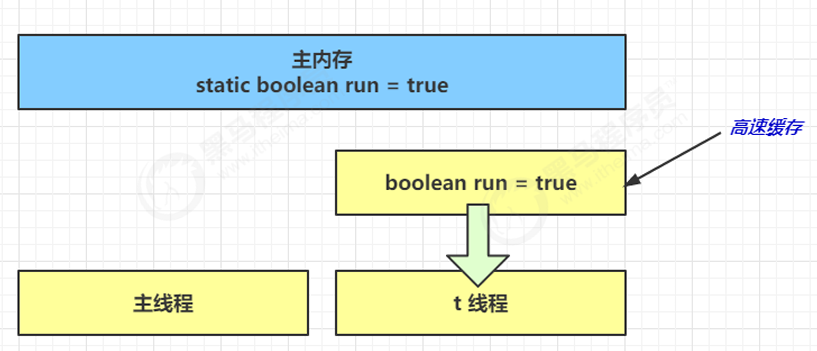java并发编程六 共享模型之内存
Java 内存模型
JMM 即 Java Memory Model,它定义了主存、工作内存抽象概念,底层对应着 CPU 寄存器、缓存、硬件内存、CPU 指令优化等。
JMM 体现在以下几个方面
- 原子性 - 保证指令不会受到线程上下文切换的影响
- 可见性 - 保证指令不会受 cpu 缓存的影响
- 有序性 - 保证指令不会受 cpu 指令并行优化的影响
可见性
退不出的循环
先来看一个现象,main 线程对 run 变量的修改对于 t 线程不可见,导致了 t 线程无法停止:
static boolean run = true;
public static void main(String[] args) throws InterruptedException {
Thread t = new Thread(()->{
while(run){
// ....
}
});
t.start();
}
sleep(1);
run = false; // 线程t不会如预想的停下来
为什么呢?分析一下:
-
初始状态, t 线程刚开始从主内存读取了 run 的值到工作内存。

-
因为 t 线程要频繁从主内存中读取 run 的值,JIT 编译器会将 run 的值缓存至自己工作内存中的高速缓存中,减少对主存中 run 的访问,提高效率

-
1 秒之后,main 线程修改了 run 的值,并同步至主存,而 t 是从自己工作内存中的高速缓存中读取这个变量的值,结果永远是旧值

解决方法
volatile(易变关键字)
它可以用来修饰成员变量和静态成员变量,他可以避免线程从自己的工作缓存中查找变量的值,必须到主存中获取它的值,线程操作 volatile 变量都是直接操作主存
可见性 vs 原子性
前面例子体现的实际就是可见性,它保证的是在多个线程之间,一个线程对 volatile 变量的修改对另一个线程可见, 不能保证原子性,仅用在一个写线程,多个读线程的情况: 上例从字节码理解是这样的:
getstatic run // 线程 t 获取 run true
getstatic run // 线程 t 获取 run true
getstatic run // 线程 t 获取 run true
getstatic run // 线程 t 获取 run true
putstatic run // 线程 main 修改 run 为 false, 仅此一次
getstatic run // 线程 t 获取 run false
比较一下之前我们将线程安全时举的例子:两个线程一个 i++ 一个 i-- ,只能保证看到最新值,不能解决指令交错
// 假设i的初始值为0
getstatic i // 线程2-获取静态变量i的值 线程内i=0
getstatic i // 线程1-获取静态变量i的值 线程内i=0
iconst_1 // 线程1-准备常量1
iadd // 线程1-自增 线程内i=1
putstatic i // 线程1-将修改后的值存入静态变量i 静态变量i=1
iconst_1 // 线程2-准备常量1
isub // 线程2-自减 线程内i=-1
putstatic i // 线程2-将修改后的值存入静态变量i 静态变量i=-1
注意 synchronized 语句块既可以保证代码块的原子性,也同时保证代码块内变量的可见性。但缺点是synchronized 是属于重量级操作,性能相对更低如果在前面示例的死循环中加入 System.out.println() 会发现即使不加 volatile 修饰符,线程 t 也能正确看到
有序性
JVM 会在不影响正确性的前提下,可以调整语句的执行顺序,思考下面一段代码
static int i;
static int j;
// 在某个线程内执行如下赋值操作
i = ...;
j = ...;
可以看到,至于是先执行 i 还是 先执行 j ,对最终的结果不会产生影响。所以,上面代码真正执行时,既可以是
i = ...;
j = ...;
也可以是
j = ...;
i = ...;
这种特性称之为『指令重排』,多线程下『指令重排』会影响正确性。为什么要有重排指令这项优化呢?从 CPU执行指令的原理来理解一下吧
- 原理之指令级并行
诡异的结果
int num = 0;
boolean ready = false;
// 线程1 执行此方法
public void actor1(I_Result r) {
if(ready) {
r.r1 = num + num;
}
else {
r.r1 = 1;
}
}
// 线程2 执行此方法
public void actor2(I_Result r) {
num = 2;
ready = true;
}
I_Result 是一个对象,有一个属性 r1 用来保存结果,问,可能的结果有几种?
有同学这么分析
情况1:线程1 先执行,这时 ready = false,所以进入 else 分支结果为 1
情况2:线程2 先执行 num = 2,但没来得及执行 ready = true,线程1 执行,还是进入 else 分支,结果为1
情况3:线程2 执行到 ready = true,线程1 执行,这回进入 if 分支,结果为 4(因为 num 已经执行过了)
但我告诉你,结果还有可能是 0 😁😁😁,信不信吧!
这种情况下是:线程2 执行 ready = true,切换到线程1,进入 if 分支,相加为 0,再切回线程2 执行 num = 2
相信很多人已经晕了 😵😵😵
这种现象叫做指令重排,是 JIT 编译器在运行时的一些优化,这个现象需要通过大量测试才能复现:
借助 java 并发压测工具 jcstress https://wiki.openjdk.java.net/display/CodeTools/jcstress
mvn archetype:generate -DinteractiveMode=false -DarchetypeGroupId=org.openjdk.jcstress - DarchetypeArtifactId=jcstress-java-test-archetype -DarchetypeVersion=0.5 -DgroupId=cn.onenewcode DartifactId=ordering -Dversion=1.0
创建 maven 项目,提供如下测试类
@JCStressTest
@Outcome(id = {"1", "4"}, expect = Expect.ACCEPTABLE, desc = "ok")
@Outcome(id = "0", expect = Expect.ACCEPTABLE_INTERESTING, desc = "!!!!")
@State
public class ConcurrencyTest {
int num = 0;
boolean ready = false;
@Actor
public void actor1(I_Result r) {
if(ready) {
r.r1 = num + num;
}
else {
r.r1 = 1;
}
}
@Actor
public void actor2(I_Result r) {
num = 2;
ready = true;
}
}
执行
mvn clean install
java -jar target/jcstress.jar
会输出我们感兴趣的结果,摘录其中一次结果:
*** INTERESTING tests
Some interesting behaviors observed. This is for the plain curiosity.
2 matching test results.
[OK] test.ConcurrencyTest
(JVM args: [-XX:-TieredCompilation])
Observed state Occurrences Expectation Interpretation
0 1,729 ACCEPTABLE_INTERESTING !!!!
1 42,617,915 ACCEPTABLE ok
4 5,146,627 ACCEPTABLE ok
[OK] test.ConcurrencyTest
(JVM args: [])
Observed state Occurrences Expectation Interpretation
0 1,652 ACCEPTABLE_INTERESTING !!!!
1 46,460,657 ACCEPTABLE ok
4 4,571,072 ACCEPTABLE ok
可以看到,出现结果为 0 的情况有 638 次,虽然次数相对很少,但毕竟是出现了。
解决方法
volatile 修饰的变量,可以禁用指令重排
@JCStressTest
@Outcome(id = {"1", "4"}, expect = Expect.ACCEPTABLE, desc = "ok")
@Outcome(id = "0", expect = Expect.ACCEPTABLE_INTERESTING, desc = "!!!!")
@State
public class ConcurrencyTest {
int num = 0;
volatile boolean ready = false;
@Actor
public void actor1(I_Result r) {
if(ready) {
r.r1 = num + num;
}
else {
r.r1 = 1;
}
}
@Actor
public void actor2(I_Result r) {
num = 2;
ready = true;
}
}
结果为:
*** INTERESTING tests
Some interesting behaviors observed. This is for the plain curiosity.
0 matching test results.
- 原理之 volatile
happens-before
happens-before 规定了对共享变量的写操作对其它线程的读操作可见,它是可见性与有序性的一套规则总结,抛开以下 happens-before 规则,JMM 并不能保证一个线程对共享变量的写,对于其它线程对该共享变量的读可见
- 线程解锁 m 之前对变量的写,对于接下来对 m 加锁的其它线程对该变量的读可见
static int x;
static Object m = new Object();
new Thread(()->{
synchronized(m) {
x = 10;
}
},"t1").start();
new Thread(()->{
synchronized(m) {
System.out.println(x);
}
},"t2").start();
- 线程对 volatile 变量的写,对接下来其它线程对该变量的读可见
volatile static int x;
new Thread(()->{
x = 10;
},"t1").start();
new Thread(()->{
System.out.println(x);
},"t2").start();
- 线程 start 前对变量的写,对该线程开始后对该变量的读可见
static int x;
x = 10;
new Thread(()->{
System.out.println(x);
},"t2").start();
- 线程结束前对变量的写,对其它线程得知它结束后的读可见(比如其它线程调用 t1.isAlive() 或 t1.join()等待它结束)
static int x;
Thread t1 = new Thread(()->{
x = 10;
},"t1");
t1.start();
t1.join();
System.out.println(x);
- 线程 t1 打断 t2(interrupt)前对变量的写,对于其他线程得知 t2 被打断后对变量的读可见(通过
t2.interrupted 或 t2.isInterrupted)
static int x;
public static void main(String[] args) {
Thread t2 = new Thread(()->{
while(true) {
if(Thread.currentThread().isInterrupted()) {
System.out.println(x);
break;
}
}
},"t2");
t2.start();
new Thread(()->{
sleep(1);
x = 10;
t2.interrupt();
},"t1").start();
while(!t2.isInterrupted()) {
Thread.yield();
}
System.out.println(x);
}
- 对变量默认值(0,false,null)的写,对其它线程对该变量的读可见
- 具有传递性,如果 x hb-> y 并且y hb-> z 那么有x hb-> z ,配合 volatile 的防指令重排,有下面的例子
volatile static int x;
static int y;
new Thread(()->{
y = 10;
x = 20;
},"t1").start();
new Thread(()->{
// x=20 对 t2 可见, 同时 y=10 也对 t2 可见
System.out.println(x);
},"t2").start();
本文来自互联网用户投稿,该文观点仅代表作者本人,不代表本站立场。本站仅提供信息存储空间服务,不拥有所有权,不承担相关法律责任。 如若内容造成侵权/违法违规/事实不符,请联系我的编程经验分享网邮箱:chenni525@qq.com进行投诉反馈,一经查实,立即删除!
- Python教程
- 深入理解 MySQL 中的 HAVING 关键字和聚合函数
- Qt之QChar编码(1)
- MyBatis入门基础篇
- 用Python脚本实现FFmpeg批量转换
- Linux常用命令
- 答案很详细的MyBatis面试题(含示例代码)
- 【建议收藏】一文全面解读Linux最常用的解压缩命令(tar、zip、unzip、gzip、guznip、bzip2、bunzip2)
- 招投标系统简介 企业电子招投标采购系统源码之电子招投标系统 —降低企业采购成本
- 教育大模型浪潮中,松鼠Ai的“智适应”故事好讲吗?
- 【野火i.MX6ULL开发板】开发板连接网络(WiFi)与 SSH 登录、上电自动登录、设置静态IP、板子默认参数
- 获取CNN/DM适用于评估Bart的格式的数据集(类似于test.source、test.source.tokenized)
- 基于无人机的消防灭火系统设计
- 【Java并发篇】什么是多线程中的上下文切换?
- SolidWorks制作蜂窝网格教程